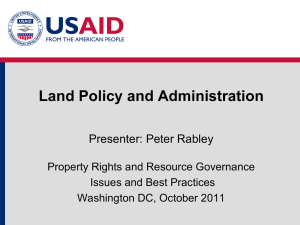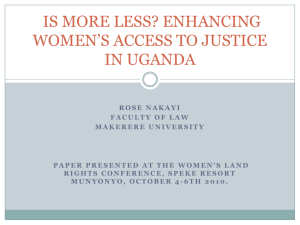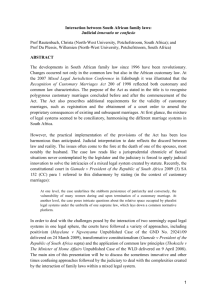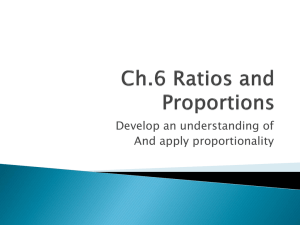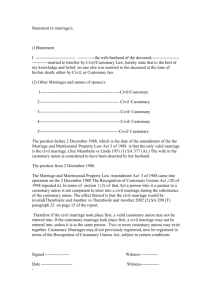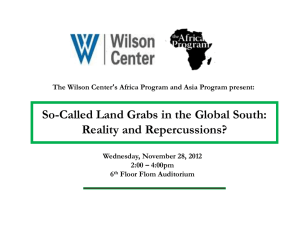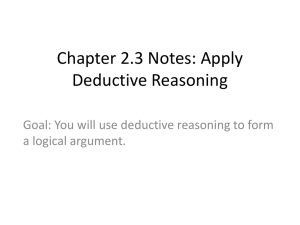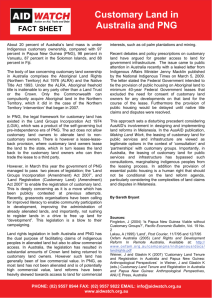Topic: Mastering Math Vocabulary
advertisement
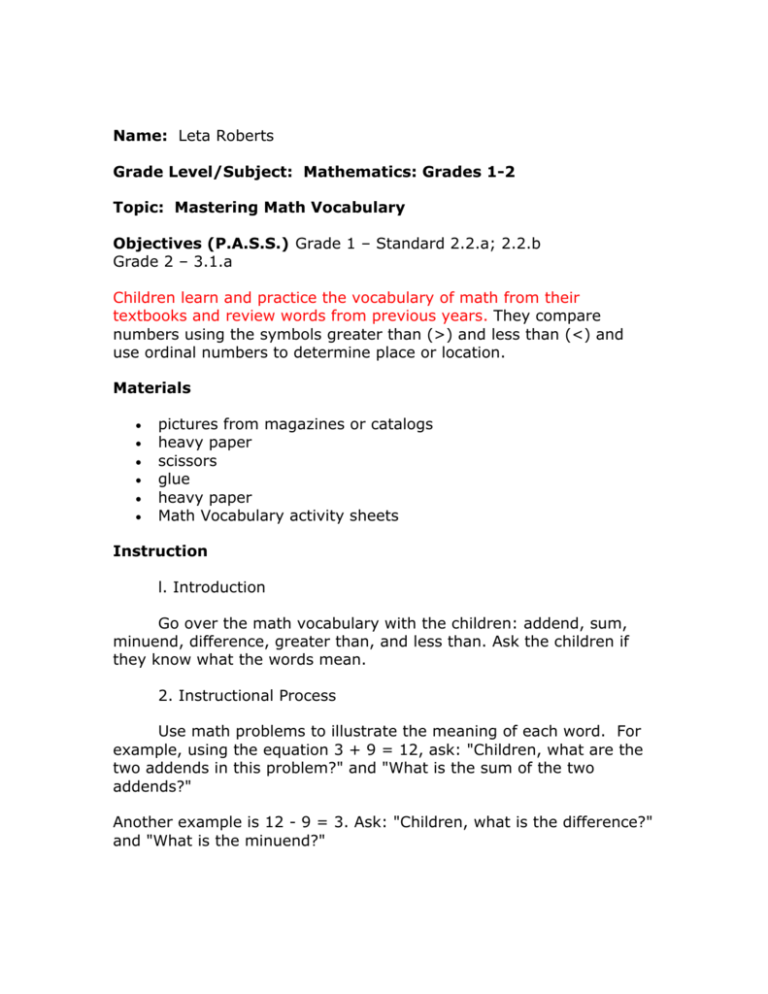
Name: Leta Roberts Grade Level/Subject: Mathematics: Grades 1-2 Topic: Mastering Math Vocabulary Objectives (P.A.S.S.) Grade 1 – Standard 2.2.a; 2.2.b Grade 2 – 3.1.a Children learn and practice the vocabulary of math from their textbooks and review words from previous years. They compare numbers using the symbols greater than (>) and less than (<) and use ordinal numbers to determine place or location. Materials pictures from magazines or catalogs heavy paper scissors glue heavy paper Math Vocabulary activity sheets Instruction l. Introduction Go over the math vocabulary with the children: addend, sum, minuend, difference, greater than, and less than. Ask the children if they know what the words mean. 2. Instructional Process Use math problems to illustrate the meaning of each word. For example, using the equation 3 + 9 = 12, ask: "Children, what are the two addends in this problem?" and "What is the sum of the two addends?" Another example is 12 - 9 = 3. Ask: "Children, what is the difference?" and "What is the minuend?" Write 3 > 0; 4 > 0; 1 < 5. Ask the children if they notice a pattern. Ask: "What is the pattern?" and “What does the pattern mean?" Tell the children that the < and > symbols mean less than and greater than. The large opening always points towards the larger number. Read the number sentences aloud, "3 is greater than 0; 4 is greater than 0; 1 is less than 5." Do this several times with different math problems so that the children feel comfortable using the words. Have the children cut pictures out of catalogs and magazines. Glue each picture on a piece of heavy paper. Place the pictures in a line on the chalkboard ledge, in a pocket chart, or on a table. Have the children pick up the picture that is third in line, first in line, last in line, 19th in line, etc. Explain that these words are ordinals. Ordinals tell the place or location of something. 3. Closure Have students complete vocabulary activity sheets which cover the words you have discussed. Go over each work sheet with the children. Assessment: Have students come to the board and show examples of each of the vocabulary concepts which have been covered. The vocabulary activity sheets can also be graded. Modifications/Accommodations: Manipulatives can be used to compare numbers (greater than and less than) and ordinal numbers. Reflection: My students enjoy the board work involved in showing the vocabulary concepts learned. They like to have their turn to be the teacher. It gives them a sense of accomplishment and allows me to see which students are having trouble with the concepts. Math Vocabulary The vocabulary is included in the grade level in which they are introduced. Each grade level builds upon the previous grade levels and reviews the previously learned vocabulary. Kindergarten Term Area Circle Even (number) Hexagon Length (l) Less than < Line Number Numeral Odd (number) Order Pattern Probability Definition The measure, in square units, of the interior region of a 2-dimensional figure or the surface of a 3-dimensional figure. A closed curve with all its points in one plane and the same distance from a fixed point (the center). A whole number that is divisible by 2. Even numbers have 0, 2, 4, 6, or 8 in the ones place. A polygon with six sides. (1) The distance along a line or figure from one point to another. (2) One dimension of a 2- or 3- dimensional figure. Smaller in size, quantity, or amount. An infinite set of points forming a straight path extending in two directions. A mathematical unit used to express a quantity or amount. A symbol (not a variable) used to represent a number. A whole number that is not divisible by 2. All odd numbers have 1, 3, 5, 7, or 9 in the ones place. A customary/standard method of procedure. A predictable sequence. The chance of an event occurring. If all outcomes of an event are equally likely, the probability of an event is equal to the number of favorable outcomes divided by the number of possible outcomes. P (event) = # of favorable outcomes/# of possible outcomes Rectangle Rhombus Sphere Square Sum Symmetry Triangle Weight A quadrilateral with two pairs of congruent, parallel sides and four right angles. A parallelogram with all four sides equal in length. A 3-dimensional figure made up of all points that are equally distant from a point called the center. A parallelogram with four congruent sides and four right angles. The result of addition. The exact/same correspondence in size, form, and arrangement of parts on opposite sides of a plane, line, or corresponding parts. A polygon with three angles and three sides. A measure of the heaviness of an object. First Grade Term 3 Dimensional drawing Addition Approximate (number) Axis (straight line) Chart Cube Cup (c) Data Diagonal Difference Feet/Foot Fraction Greater Greater than > Inch Neighbor Perimeter Point Prediction Variable Volume (capacity) Whole (number) Width Definition Existing in 3 dimensions; having length, width, and height. To combine numbers. A number that describes another number without specifying it exactly. A reference line from which distances or angles are measured on a coordinate grid. A graphic organizer of data. (1) A regular solid with six congruent square faces. (2) The third power of a number. A customary unit of capacity equal to 8 fluid ounces. Information, especially numerical information. Usually organized. A line segment that joins two vertices of a polygon BUT it is not a side of the polygon. The amount that remains after one quantity is subtracted from another. A customary unit of length equal to 12 inches. Plural of foot is feet. A way of representing part of a whole or part of a group by showing the number of equal parts in the whole below the number of those parts you are describing. Larger quantity. A symbol which compares the quantities of two numbers. A customary unit of length equal to 1/12 foot. In numerical order, one more or one less than a specified number. The distance around the outside of a figure. An exact location in space. Using a sample to predict/decide what is likely to occur. (1) A quantity that can have different values. (2) A symbol that can stand for a variable. The number of cubic units it takes to fill a solid. Any of the numbers 0, 1, 2, and so on. One dimension of a 2-or 3-dimensional figure. Second Grade Term 2 Dimensional Addend Angle Capacity Digit Equation Equivalent Estimation Flip/reflection Grid Least common multiple Less than < Mass Median Mile Mode Multiplication sentence Parallel Pint Place value Polygon Pound Product Quadrilateral Quart Range Regroup Remainder Right angle Definition Existing in 2 dimensions; having length and width. Any number being added. Two rays that share an endpoint. The maximum amount that can be contained by an object. Any one of the tem symbols 0, 1, 2, A statement that two mathematical expressions are equal. Having the same value. Finding a number that is close to an exact amount; an estimate tells about how much or about how many. A transformation creating a mirror image of a figure on the opposite side of a line. A pattern of horizontal and vertical lines, usually forming squares. The smallest common multiple of a set of two or more numbers. Smaller in size, quantity, or amount. The amount of matter in an object. When the numbers are arranged from least to greatest, the middle number of a set of numbers, or the mean of two middle numbers when the set has two middle numbers. A customary unit of distance equal to 5280 feet or 1760 yards. The number that appears most frequently in a set of numbers. There may be one, more than one, or no mode. An equation which shows a product. Example: 3 x 8 = 24 Always the same distance apart. A customary unit of capacity equal to 2 cups. The value of the position of a digit in a number. A closed plan figure formed from line segments that meet only at their endpoints. A customary/standard unit of weight equal to 16 ounces. The result of multiplication. A four-sided polygon. A customary/standard unit of capacity equal to 2 pints or 16 ounces. The difference between the greatest and the least value in a set of data. Use place value to think of a number in a different way to make addition and subtraction easier. In whole-number division, when you have divided as far as you can without using decimals, what has not been divided yet is the remainder. An angle that measures exactly 90 degrees. Similar Slide/translation t-chart Turn/rotation Yard Figures that have the same shape, but not necessarily the same size. The transformation that slides a figure a given distance in a given direction. A two column graphic organizer of information. A transformation in which a figure is turned a given angle and direction around a point. A customary/standard unit of length equal to 3 feet.

